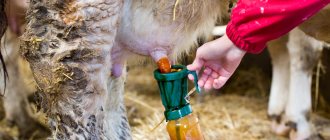General information about the infection
The causative agent of brucellosis is the bacterium Brucella, the main reservoir for which is domestic and wild animals and birds. Human infection occurs through contact with an infected animal. The routes of transmission of brucellosis are small wounds on the skin or mucous membranes, the digestive tract when consuming products of animal origin, and the respiratory tract when inhaling air with infected dust.
Infection of a person is possible only from an animal. The existence of tick-borne brucellosis has not been proven - not a single case of transmission of this infection through tick bites has yet been recorded.
Brucella can be found not only in the body of animals, but also on their fur, in milk and even in frozen meat, as well as in the soil, where they fall with animal feces. The bacterium is excellently adapted to unfavorable conditions, maintaining viability at low temperatures and in the absence of moisture from one and a half to six months. However, it dies within half an hour when heated to 60°C, and when boiled it is destroyed instantly. Therefore, eating animal products after heat treatment is completely safe.
Brucellosis
Allergy
Arthritis
Encephalitis
10158 20 January
IMPORTANT!
The information in this section cannot be used for self-diagnosis and self-treatment.
In case of pain or other exacerbation of the disease, diagnostic tests should be prescribed only by the attending physician. To make a diagnosis and properly prescribe treatment, you should contact your doctor. Brucellosis: causes, symptoms, diagnosis and treatment methods.
Definition
Brucellosis is an infectious disease caused by bacteria of the genus
Brucella
.
These bacteria are highly resistant in the environment and can remain viable for a long time.
In Russia, the disease occurs in the southern regions where livestock farming is developed. Professions associated with an increased risk of contracting brucellosis are shepherds, milkmaids, veterinary and zootechnicians, employees of bacteriological laboratories, workers in meat processing plants, slaughterhouses and factories processing animal wool.
Causes of brucellosis
Brucella is transmitted to humans from sick animals, mainly goats and sheep.
Transmission of Brucella occurs through food (thermally untreated milk and dairy products, meat), direct contact with sick animals, as well as through inhalation of Brucella contained in dust in the habitats of sick animals and during cutting of their carcasses.
Brucella can penetrate the placenta, leading to intrauterine infection of the fetus, and can also be excreted in breast milk.
Transmission of Brucella from person to person is impossible by other means.
After entering the human body, Brucella intensively multiplies in lymphoid tissue.
Brucella can persist in the body for a long time and unnoticed by humans, causing a chronic course of infection.
Classification of the disease
Brucellosis can develop as a result of infection with various types of Brucella, for example,
Brucella melitensis, Brucella abortus
. There are certain features of the course of brucellosis caused by different types of pathogens, but these differences relate mainly to epidemiological aspects.
Depending on the duration of the disease, brucellosis can be acute, subacute and chronic. Separately, residual (residual) changes are distinguished that persist after recovery from infection and liberation of the body from the pathogen.
Symptoms of brucellosis
The first symptoms of the disease usually appear 1–6 weeks after infection.
More often, brucellosis begins subacutely - nonspecific symptoms occur, such as weakness, malaise, headache, joint and muscle pain.
The increase in temperature in the subacute period is insignificant, followed by a rise to higher values. Fever often has a wave-like course. In rare cases, enlargement of the lymph nodes is observed, and painful subcutaneous nodules are found.
Brucellosis is characterized by allergic manifestations on the skin (diffuse redness, rashes, etc.).
From the cardiovascular system, there is a decrease in blood pressure, an increase in heart rate, and the possible development of inflammatory processes in the heart. Damage to the respiratory system (bronchitis, pneumonia, etc.) may also occur.
Chronic brucellosis is characterized by damage to the musculoskeletal system, expressed by joint and muscle pain and limited joint mobility.
Damages to the nervous system are manifested by burning and tingling along the nerve fibers.
Diagnosis of brucellosis
Diagnosis of brucellosis consists of a thorough history taking and objective examination of the patient.
Laboratory methods used in the diagnosis of brucellosis include a clinical blood test with the determination of the leukocyte formula, in which signs of an inflammatory process in the body can be detected. However, this method does not provide identification of the pathogen. For this purpose, bacteriological, serological and molecular genetic methods are used.
Symptoms of the disease
At least a week passes between the penetration of the bacterium into the body and the appearance of the first signs of brucellosis; sometimes the incubation period lasts up to two months, but its most common duration is two weeks. Symptoms develop gradually and include:
- a strong increase in body temperature to 38-39°C, accompanied by chills and fever;
- increased sweat production, especially during night sleep;
- a sharp loss of strength, a feeling of weakness;
- the appearance of painful sensations in the joints of the limbs, tingling in different parts of the body.
The listed symptoms of brucellosis can be wave-like: gradually increase and intensify, then decrease and disappear for a while. The disease is systemic in nature and affects the human musculoskeletal system, nervous system and reproductive organs, provoking the development of associated ailments.
Pathogenesis
The development of brucellosis in humans goes through several stages.
- Lymphogenic - bacteria penetrate the lymphatic system and occupy the lymph nodes with the lymph flow, without leading to their enlargement.
- Hematogenous drift - having penetrated the circulatory system, bacteria release toxins that, through the blood, affect nerve fibers.
- Acute brucellosis - bacteria penetrate through the bloodstream into the tissues of various organs, forming secondary foci of infection in the form of granulomas and sometimes inflammatory abscesses.
- Exofocal contamination - new foci of infection appear, the body develops an allergic reaction to unfavorable factors, chronic brucellosis forms, which continues for several years with numerous relapses;
- Residual effects are the final stage of the disease, which is characterized by deformation of bone tissue and joints, allergic manifestations and disorders of the nervous system, which are usually irreversible.
After the completion of the disease, the patient develops temporary immunity, the duration of which ranges from six months to five years, after which the person can become infected again.
Detection of infection
The method for diagnosing brucellosis is well developed and is based on laboratory tests aimed at identifying the pathogen, which include:
- general blood test;
- biochemical blood test;
- bacterial seeding of biomaterials;
- serological study;
- blood test to detect antigens;
- PCR test for the presence of Brucella DNA;
- testing for antibodies to Brucella.
In addition, ultrasound and x-ray examinations of damaged organs may be needed to identify pathological changes in the patient’s body.
Prevention and control
Prevention of brucellosis is based on surveillance and prevention of risk factors. The most effective prevention strategy is to eliminate infection in animals. In areas with a high prevalence of enzootic diseases, vaccination of cattle, goats and sheep is recommended. In areas with low infection rates, serological and other tests and livestock culling may also be effective. In countries where prevention of infection in animals by vaccination or destruction of infected animals is not possible, prevention of infection in humans relies primarily on awareness-raising, food safety measures, occupational hygiene and laboratory safety.
Pasteurizing milk for direct consumption and making products such as cheese is an important step to prevent animal-to-human transmission. Educational campaigns aimed at preventing the manufacture of unpasteurized milk products can be effective, as can policies regarding the marketing of such products.
In agriculture and meat processing, an important prevention strategy is the provision of protective barriers and the proper handling and disposal of animal placentas, carcasses and internal organs.
How to treat brucellosis
Antibiotics are prescribed to treat acute brucellosis. When the disease becomes chronic, these drugs cease to be effective; immunoglobulins with anti-brucellosis antibodies and vaccines with killed bacteria have a much more pronounced effect. Supportive and strengthening therapy is important - ultraviolet irradiation sessions, taking vitamin complexes, etc. If an allergic reaction occurs, antiallergic drugs are prescribed. During the recovery period, visiting balneological resorts with radon and sulfur-radon waters is recommended.
How to prevent disease
Unfortunately, the development of an effective long-acting vaccine that prevents the development of infection in humans has proven impossible. However, if you follow simple measures to prevent brucellosis, you can completely avoid the disease. To do this you need:
- boil or pasteurize milk before consumption;
- avoid eating dry-cured meat products;
- observe hygiene rules, wash hands after contact with animals, agricultural workers wear protective gloves;
- vaccinate livestock, since a vaccine against brucellosis for animals has long been developed, and in countries that practice universal vaccination of livestock, this disease has practically disappeared.
In case of contact with an infected animal, it is necessary to monitor the state of health for at least six months, periodically taking tests for the presence of bacteria in biomaterials.
Prevention
Preventive measures are quite simple and do not require the organization of any serious actions.
To prevent infection with brucellosis, you must adhere to the following recommendations:
- veterinary control and monitoring of the health of animals on farms and other agricultural lands;
- proper production, storage, transportation, preparation and consumption of food;
- preventive examinations of agricultural workers - at least once a year;
- vaccination of farm livestock;
- vaccination of people who regularly come into contact with animals;
- wearing protective clothing by workers interacting with animal raw materials;
- compliance with personal hygiene rules.
The combination of all preventive measures significantly reduces the risk of contracting brucellosis. If you or your loved ones suspect a possible illness, consult a doctor as soon as possible.
Express Your Reaction
Similar articles:
There is fog in the eyes, ache in the bones
One day in the middle of the night I woke up with severe pain in my hip joint. A few days later the situation...
Cat - furry doctor
A cat cured me. I decided to write about how the cat Milka helped me heal. I'm already over 70! B...
Zootherapy or animals as “aibolites”
It is known that animals help us find peace of mind. This is especially important for people with disabilities…











